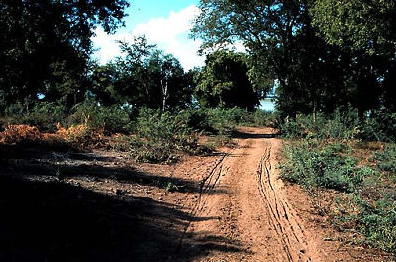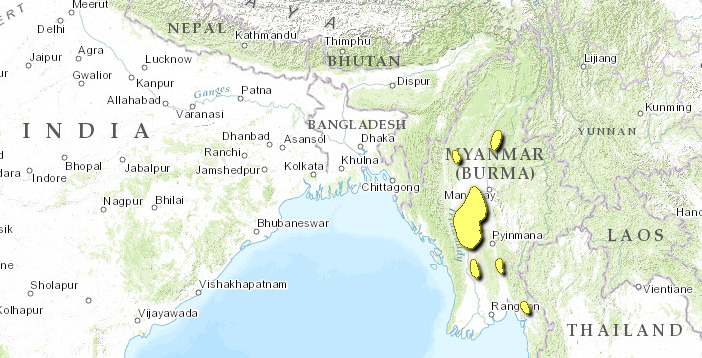Irrawaddy dry forests
Introduction The Irrawaddy Dry Forests, like the surrounding moist deciduous forests, have been under intensive conversion pressure for hundreds of years. However, until recently most of its large mammal fauna, such as the tiger, still persisted in the degraded forests. Only recently has the larger mammal fauna been hunted to the brink of extinction in this ecoregion (Irrawaddy dry forests) . The little protection afforded this ecoregion has hindered conservation efforts.
Location and General Description
This ecoregion falls in the dry zone of central Myanmar. The region has a harsh climate and is extremely dry. The average rainfall is about 650 millimeters (mm) per year. Rains start in mid-July and last until October. There are rarely more than fifteen days of rain per year. When rainfall does occur, it falls in torrential showers. In addition to rains, the dry zone is subject to southerly winds during the summer, resulting in wind erosion of the topsoil.
The soil substrate is primarily soft sandstone and clays and belong to the Irrawaddian series. The wide diurnal temperature range weathers the soft rocks. The weathered rocks and soil are then washed away during seasonal showers. Therefore, the landscape of the dry zone is marked with exposed rocks. Besides the harsh climate, the region is extremely short of potable water. There is no underground water recharge because of uncontrolled surface runoff and the low moisture retention of the subsoil. This causes an extreme water shortage.
The forests in this ecoregion are dominated by dry forests where rainfall is less than 800 millimeters. The stands are low in stature, with thorny trees. Common species include Terminalia oliveri and Tectona homiltoniana. Trees associated with them are Acacia catechu and Bauhinia racemosa. Pests such as Euphobia neriifolia, E. nirculia, E. tirucalli, and the introduced Prosopsis juliflora are hard to eradicate. They characterize the dry zone low-growing degraded forests.
There are also two types of dipterocarp forests: high Indaing and low Indaing. The former produces big timber, whereas the growth of the latter is stunted by repeated cutting and burning of high Indaing. Both types are widespread, but the low type is more common in the dry zone. There are stands of pure Dipterocarpus tuberculatus among the typical Indaing forests of Shorea oblongifolia and Pentacme siamensis.
A dry mixed deciduous forest also occurs in this ecoregion. Teak dominates these forests. Bamboo such as Dendrocalamus strictus, Bambusa polymorpha, and B. tulda are also common in these forests.
Biodiversity Features
The larger mammals historically found in this ecoregion have been extirpated. Wildlife found in the protected areas includes medium and small mammals. Numerous species of deer such as barking deer (Muntiacus muntjak), Eld's deer (Cervus eldi), or sambar deer (Cervus unicolor) persist. Primate species include the rhesus macaque (Macaca mulatta) and Hoolock gibbon (Hylobates hoolock). Mid-sized predators such as the jungle cat (Felis chaus), Asiatic jackal (Canis aureus indicus), and perhaps leopard (Panthera pardus fuscus) also persist. A single endemic mouse also is found in this ecoregion (Table 1).
|
Table 1. Endemic and Near-Endemic Mammal Species. Family Species Muridae Millardia kathleenae* An asterisk signifies that the species' range is limited to this ecoregion. The birds include more than 300 species, including two rare wetland birds: the black stork (Ciconia nigra) and the woolly-necked stock (Ciconia bicolor). Two near-endemic species are found in this ecoregion (Irrawaddy dry forests) (Table 2). This ecoregion also overlaps with the Irrawaddy Plains Endemic Bird Area, EBA (132), which contains two restricted-range bird species, corresponding to our near-endemic species. {| border="1" cellpadding="3" align="right" ! colspan="3" align="center" | Table 2. Endemic and Near-Endemic Bird Species. Family Common Name Species Corvidae Hooded treepie Crypsirina cucullata Timaliidae White-throated babbler Turdoides gularis An asterisk signifies that the species' range is limited to this ecoregion. Among reptiles (Irrawaddy dry forests) , the dry zone is famous for vipers, including the Burmese python (Python molurus bivittatus). Turtles such as the yellow tortoise (Testuo elongata) and soft-shelled turtle (Trionyx spp.) were once common but now are intensively collected for food. ==Current Status== Most of the forests in this ecoregion have been converted to agriculture or degraded. The forests that do exist are degraded and lack the full complement of species. Those that did survive have been under intense hunting pressure. In the past twenty years the increased demand and population have driven many of the larger species to the brink of extinction within this ecoregion. Only one nature reserve exists in this ecoregion that meets our IUCN criteria (Table 3). This ecoregion is poorly protected, and the protected areas currently gazetted provide little real protection to its wildlife and forests. {| border="1" cellpadding="3" align="left" ! colspan="3" align="center" | Table 3. WCMC (1997) Protected Areas That Overlap with the Ecoregion. Protected Area Area (km2) IUCN Category Wethtigan 4 UA Ecoregion numbers of protected areas that overlap with additional ecoregions are listed in brackets. (Irrawaddy dry forests) ==Types and Severity of Threats== The threats to this ecoregion are similar to those facing all of Myanmar and its neighboring countries. Conversion of forests to agricultural land causes habitat loss and fragmentation of the remaining habitat. A large percentage of this conversion is illegally done. Poaching and the illegal trade of animals and their parts are rampant. The lack of protected areas and the political will to prosecute poachers leave the remaining forests devoid of wildlife. ==Justification of Ecoregion Delineation== MacKinnon divided the Indochina bioregion into fifteen biogeographic subunits nested within seven major biounits. Each of these biounits and biogeographic subunits contains a mix of biomes. MacKinnon's deciduous forests subunit (09a) is represented by the Irrawaddy Dry Forests and the Irrawaddy Moist Deciduous Forests. This region does not correspond well to Udvardy's biogeographic provinces. The Myanmar Coastal Rain Forestscover the Udvardy's Burman rain forest, southwestern portion of the Thai monsoon forest, and western portion of the Indochinese rain forest. The Irrawaddy Moist Deciduous Forests, Irrawaddy Dry Forests, Chin Hills-Arakan Yoma Montane Rain Forests, Northeast India-Myanmar Pine Forests, and Mizoram-Manipur-Kachin Rain Forests roughly correspond to Udvardy's Burman rain forest and Burma monsoon forest. ==Additional Information on this Ecoregion== * For a shorter summary of this entry, see the WWF WildWorld profile of this ecoregion. * To see the species that live in this ecoregion, including images and threat levels, see the WWF Wildfinder description of this ecoregion. * World Wildlife Fund Homepage |
|---|

